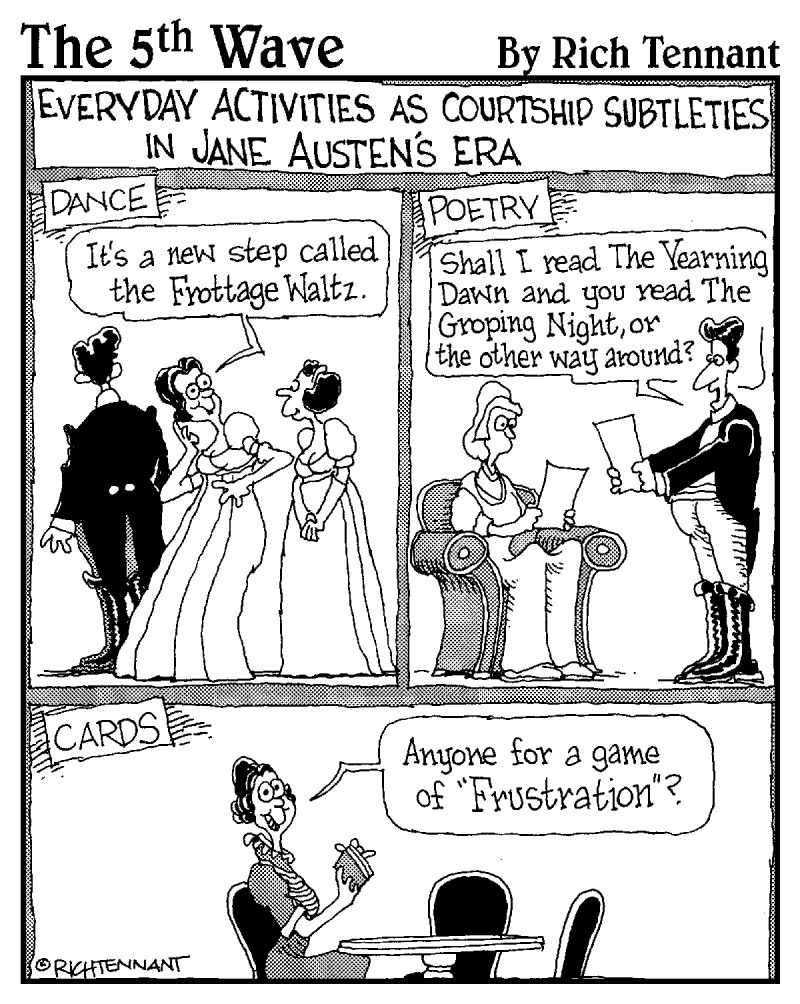Jane Austen For Dummies (19 page)
Read Jane Austen For Dummies Online
Authors: Joan Elizabeth Klingel Ray

Like the novel genre, itself, Austen's skills as a novelist grew over time. Austen intellectually absorbed the novel form by
 Starting to write at age 12
Starting to write at age 12
 Sharing her writing with her well-read family
Sharing her writing with her well-read family
 Having an unquenchable reading habit in her father's excellent library
Having an unquenchable reading habit in her father's excellent library
 Discussing what she read with her family of readers
Discussing what she read with her family of readers
Using a third-person, omniscient, or all-knowing, narrator (the voice that tells the story), Austen is able to present the interior workings of her characters' minds without resorting to Richardson's device of letter writing. And while she said that she never modeled a character on Mr. A. or Mr. B., her letters show how closely she observed human behavior â taking one character facet from here, another from there, and still others from her own creative imagination to present vivid characters: characters like the nosey Mrs. Jennings, the restrained Elinor Dashwood, or the clueless Emma Woodhouse. In her own way, Austen combines the characters of nature with the characters of manners that she knew from reading Richardson and Fielding.

Austen's characters are so realistic that many of her readers go to sequels written by other authors to fill their need to learn the future of the characters' lives! (For more on the sequels, see Chapter 1.)
Like Fielding, Austen is a satirist. She looks around her world and sees both the charming and the correctable. Like Mary Crawford in
Mansfield Park,
Austen could say of herself, “âI do not pretend to set people right, but I do see they are often wrong'” (1:5). The characters in her novels show us that:
 Noble titles and rich estates don't necessarily make true ladies and gentlemen.
Noble titles and rich estates don't necessarily make true ladies and gentlemen.
 Family life is far from guaranteeing what today is called “family values.”
Family life is far from guaranteeing what today is called “family values.”
 Father doesn't always know best and neither does mother.
Father doesn't always know best and neither does mother.
 Social and economic times were changing.
Social and economic times were changing.
 Greed frequently operates in people when you least expect it.
Greed frequently operates in people when you least expect it.
 First impressions will always leave us clueless.
First impressions will always leave us clueless.
She achieves the above points with wit, irony, and sensitivity to human nature, so her characters remain with us long after the novel is closed.
Austen Observes Ladies and Gentlemen

In this part . . .
E
ver wonder while reading
Pride and Prejudice
why Mrs. Bennet is thrilled that Bingley has danced twice with her eldest daughter, Jane, but there's no talk of their dancing together three times? Or why in
Sense and Sensibility
, Elinor is shocked that her sister, Marianne, isn't engaged to Willoughby, even though Marianne has written letters to him? Austen's ladies and gentleman danced and courted according to certain rules. Although characters' actions may seem strange to you, they were or weren't following the protocol of the times for persons of their class. Even marrying meant arranging legal “settlements” and “articles.” Part II clues you in on all this. Plus, there's a chapter on Austen's ladies and gentlemen who don't â for shame â act like ladies and gentlemen!
